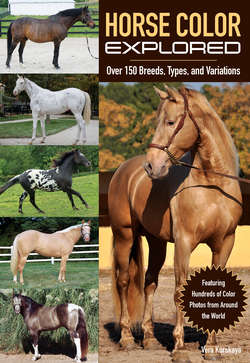Читать книгу Horse Economics - Vera Kurskaya - Страница 30
На сайте Литреса книга снята с продажи.
Double Cream Dilution
ОглавлениеHorses homozygous for the Cream Dilution gene (double cream) are characterized by light-beige color, varying from pale cream or almost white to saturated yellow (Photo 24). The skin is pink and eyelashes yellow or reddish. The eyes are most often blue, although you can also find golden, green, and greenish-blue with amber specks. In old literature on the subject, this color was not differentiated from light palomino (see p. 19).
In the past double cream diluted color was considered the manifestation of albinism, but this is incorrect. Albinism assumes the absence of any pigment in the hair and skin. White marks on the nose and legs are clearly visible in double cream diluted horses, consistent with the presence of pigment. The mane and tail could be the same color as the body, but it can also be brighter (white), or darker. When present, dapples on these horses have a light coffee color. The intensity of the color can be of an average shade, or light or dark.
Regardless of their base color, double cream horses all have the same name in the Russian language: “Isabell.” However, there are distinctive terms used in the United States and elsewhere, depending on the base colors: cremello (chestnut base), perlino (bay base), and smoky cream (black base). Barbara Kostelnik (2008) uses brown cream for homozygous cream combined with the seal brown base. In reality, all these terms are names based on genotypes. In the United States the opinion exists that it is possible to make a conclusion about the genotype of a horse from the shade of the color. It is believed that in cremello horses, the mane and tail can be white, pale cream, or reddish; in perlino the mane and tail are light brown or ashy, as well as the lower part of the legs; and in smoky cream there is a light ashy tone of the body, mane, and tail. However, studies have not revealed a precise correlation between these nuances of hair color and the genotype of double cream horses.
Foals are born very light, almost white, with pink skin and light blue eyes. Sometimes, when grown a little more, the foal’s coat can have a light golden tinge. Double cream horses are vulnerable to the sun and frequently suffer from burns on the nose, and sometimes also from skin cancer. Their eyes are sensitive to the bright sunlight. Long sun exposure can cause their skin to become spotty, as they develop reddish pigmented areas (so-called “pumpkin color”), and sometimes can even become gray, especially around the eyes. Because of the sensitivity to sun, this color was actively selected against by breeders in different parts of the world, Australia or Turkmenistan, for example.
Double cream dilute colors are relatively rare, and as might be expected are found in breeds in which other variants of Cream Dilution occur (palomino, buckskin, smoky black). Examples include the Lusitano, American Saddlebred, Tennessee Walker, Icelandic Horse, Miniature Horse, Paso Fino, Peruvian Paso, Quarter Horse, Welsh Pony, Australian Pony, Shetland Pony, Kinsky, Akhal-Teke, and Byelorussian Harness Horse.
